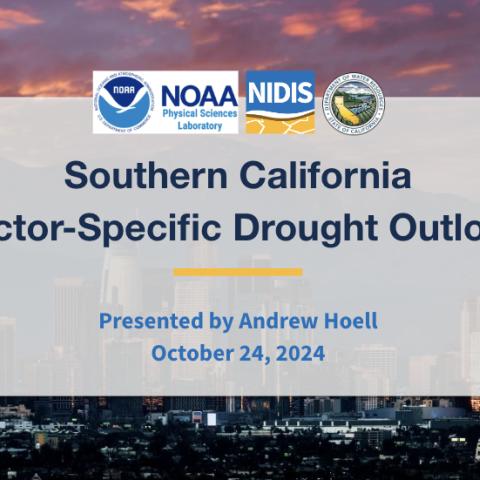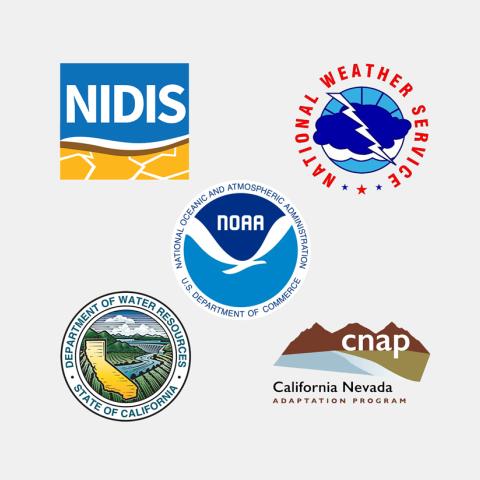Drought Early Warning: A Modern, Sector-Specific Approach
Piloting A Modern Approach to Drought Early Warning

NOAA’s National Integrated Drought Information System (NIDIS) and Physical Sciences Laboratory are partnering with the California State Climatologist/California Department of Water Resources, NOAA’s National Weather Service (NWS) and National Centers for Environmental Information (NCEI), and the California-Nevada Adaptation Program (a NOAA CAP team) to deliver a user-oriented and evidence-based approach to drought early warning for sectors of our Nation’s economy susceptible to the hazards of too much and too little water.
This partnership will pilot a drought resilience framework for Southern California over the 2024–2025 wet season. It will produce sector-specific drought scenarios delivered via a virtual briefing and a related document that are based on tailored monitoring and forecasting information, which will enable users to make proactive decisions ahead of drought.
Water Year 2025 Pilot: Southern California
The pilot builds on well-established California-Nevada Drought Early Warning System (DEWS) communication and partner networks. Key outputs of this modern approach to drought early warning include scenarios that provide users with sector-specific, forward-looking outlooks of the most likely drought outcomes relevant to their decisions. Partners may use these scenarios to determine their own drought risk, project likely drought impacts, and guide proactive decision-making across the region of interest. Drought scenarios are based on integrated information products, services, and experimental applications that include observations, forecasts, and deep knowledge of local-to-regional-scale drought behavior. The targeted sectors for this regional pilot are agriculture, water utilities, and public health.
This effort builds upon the call from the 2019 National Drought Forum to “communicate drought conditions, outlooks, and impacts through vehicles tailored to specific watersheds, populations, and sectors.” The pilot will support discovery of the feasibility, opportunities, and barriers to deliver sector-specific drought early warning information, integrate users’ needs and feedback in real time, and determine scalability to other regions and sectors. It will also offer opportunities to evaluate and incorporate new monitoring and forecast information in a user-centric approach.
For more information, contact Amanda Sheffield (amanda.sheffield@noaa.gov), Veva Deheza (veva.deheza@noaa.gov), and Andrew Hoell (andrew.hoell@noaa.gov).

Anticipated Project Milestones
The Sector-Specific Drought Early Warning Outlook – Southern California Pilot began with a collaborative session in September 2024, which brought together decision-makers and information providers from the agricultural, water utility, and public health communities in Southern California.
NOAA’s National Integrated Drought Information System (NIDIS) and Physical Sciences Laboratory (PSL) and partners released the first Sector-Specific Drought Early Warning Outlook for Southern California in October 2024, with 6–8 subsequent outlooks from October 2024–May 2025. In May–June 2025, the team will reflect on the successes, challenges, and potential scalability of the pilot.


Water Year 2025 Pilot Outlooks
The pilot team will deliver drought early warning information and sector-specific drought scenarios monthly from October 2024–May 2025 via a virtual outlook presentation and companion document on Drought.gov.
Are you in Southern California? Are you involved in the water utilities, agriculture, or public health sector and interested in contributing to this pilot? Contact Amanda Sheffield (amanda.sheffield@noaa.gov).
View past and upcoming outlooks below:

Frequently Asked Questions
What’s our vision and mission?
Our vision is improved drought resilience for our Nation’s economic sectors. Our mission is to inform early warning decision-making with co-developed, sector specific, and evidence-based drought intelligence.
Who has been invited to participate?
Decision makers and information providers from the agricultural, water utility, and public health communities in or related to Southern California. Southern California includes Imperial, Los Angeles, Orange, Riverside, San Bernardino, San Diego, San Luis Obispo, Santa Barbara, and Ventura counties.
What is an early warning system?
“An integrated system of hazard monitoring, forecasting and prediction, disaster risk assessment, communication and preparedness activities systems that enables individuals, communities, governments, etc. to take timely action to reduce disaster risks in advance of hazardous events.” – Adapted from Early Warnings for All Executive Action Plan
Our integrated approach involves users and focuses on co-developed, evidence-based, and sector-specific scenarios. This approach identifies drought risks with users, creates future drought scenarios based on the best available evidence, and shares and revises understandable and actionable drought scenarios. This supports the development of future drought response strategies to inform future drought assessment, analysis, and communication.


